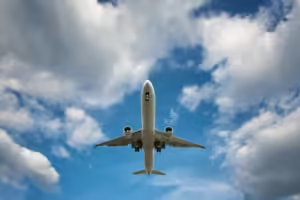The flying anxiety treatment process typically involves a combination of strategies and therapies to reduce fear, manage worries, and gradually build confidence in flying. Treatment for anxiety while flying, such as I offer, is structured and, for most people, highly effective. Here’s a general outline of the treatment process, followed by an example of reducing the strength of the anxiety and flying connection.
Flying Anxiety Treatment Goals
The first step in flying anxiety treatment is setting goals. I usually set three overall goals for this type of treatment. However, the actual details can vary based on the severity of the anxiety and anxiety connection and your specific needs. Here are some common treatment goals for flying anxiety.
Understanding and Education
By the end of treatment, I hope to help you better understand the mechanics of flying, the safety measures in place, and the statistics supporting air travel safety. Providing accurate information about the various aspects of flying can help dispel misconceptions and irrational fears. This is an essential initial step in cognitive-behavioral treatment and will be the backdrop against which we will later identify and challenge negative thought patterns and beliefs related to traveling by airplane.
Flying Anxiety Treatment Toolkit
I want to work to help you develop a toolkit that helps you with your particular fears. This toolkit will be uniquely tailored to when you experience your fears. It may include visualization, deep breathing, progressive muscle relaxation, biofeedback, positive self-talk, and mindfulness meditation. It may also include building a positive support network and communicating more effectively when fearful. Finally, it may include other aspects of self-care before and after flights, such as ways to fall asleep, nutrition tips, and exercise ideas.
Exposure and Goal Setting
The other goal of flying anxiety treatment is exposure through technology such as virtual reality that can simulate anxiety and flying experiences in a controlled environment, guided visualization, or actual slights. We will set goals to gradually increase exposure at a pace that you are comfortable with, perhaps starting with just visiting an airport without boarding an airplane and watching planes take off and land. I want you to feel a sense of accomplishment after these steps!
Flying Anxiety Treatment Initial Steps
The first step we will do is to educate you about flying and aviation. Learning about the safety measures, statistics, and the science behind flight can help dispel myths and misconceptions contributing to fear. That will help us start identifying and challenging negative thought patterns related to anxiety while flying. Our goal will be to replace irrational fears with more rational and realistic beliefs.
What Causes Anxiety While Flying
It’s not always essential to know precisely where anxiety and flying became connected in the first place. In fact, for many people, the reason stays elusive even if we try. The good news is that, unlike many other challenges I treat, knowing the reasons is not essential. We will still talk about it since many people are curious about why this is happening. There are different reasons that people describe for their flight anxiety, including:
- Fear of the unknown: Many people fear the novel aspects of flight, such as the sensation of being in the air, turbulence, and the complexity of aircraft systems. This fear is often overcome after a few flights, though avoidance of flying due to these fears can lead to increased fear.
- Fear of crashes: Although statistically rare, concerns about plane crashes can be a significant source of worry. High-profile aviation incidents in the media, as can realistic depictions in movies and TV, can exacerbate this fear and connect anxiety and flying.
- Claustrophobia: The limited space within an aircraft cabin can trigger a fear of enclosed spaces, especially on long flights, as can a fear of heights.
- Lack of control: Passengers have no control over the flight, which can be distressing for those who like to control their environment. Turbulence can cause discomfort for many passengers who want to feel like they have control, even though it’s a normal part of flying.
- Fear of terrorism: Concerns about terrorism and hijacking can connect flying and anxiety, especially in the aftermath of high-profile incidents.
- Previous traumatic experiences: Individuals who have experienced a traumatic flight or other stressful incidents during travel may develop flight anxiety as a result.
Less Common Causes of a Anxiety and Flying Connection 
- Social anxiety: Some people may fear the social aspects, such as sitting close to strangers or worrying about interactions with attendants and fellow passengers.
- Health concerns: People with medical conditions or fearing becoming ill on an airplane may experience fear.
- Fear of flying alone: Flying without a companion can be a source of fear for some individuals.
- Generalized anxiety: People with a tendency toward worry may experience a flying and anxiety connection due to the stressors and uncertainties associated with air travel.
- Noise and discomfort: The loud sounds, crowded conditions, and the discomfort of sitting in a confined space for an extended period can contribute to anxiety.
It’s important to note that anxiety while flying can range from mild discomfort to a debilitating condition. Many strategies, including therapy, relaxation techniques, and medications, can help individuals manage and overcome their flight anxiety. If you or someone you know struggles with this, consider seeking support from a mental health professional or a flight anxiety program to address the specific triggers and fears.
Exposure and Relaxation
Our next step is to gradually – at a comfortable pace – expose yourself to the aspects of the flying and anxiety connection. This could start with looking at pictures of airplanes, then watching videos of takeoffs and landings, and eventually progressing to simulated flights and actual flights. At this point, we will also work on relaxation techniques that might include deep breathing exercises to calm your body’s physiological responses to anxiety and flying, learning to relax your muscles systematically to reduce tension and promote a sense of calm, and mindfulness and meditation, which help you stay focused on the present moment and reduce excessive worrying about the future.
Adjunctive Therapy
We might use virtual reality to allow you to experience anxiety and flying in a controlled and simulated environment. It can be a helpful tool for gradually desensitizing yourself to anxiety while flying. We might also see if there are local support groups if you want to connect with others who share similar fears and can provide a sense of understanding and community. Sharing experiences and coping strategies can be empowering.
While medications may help some people, they do not cure flying anxiety. You can talk to your primary care provider about medications for short-term relief while we work on fixing things longer-term.
Flying anxiety is sometimes the only presenting concern when people come for treatment, but at other times, there are other anxieties that people want to work on. I can tailor my services in either case.
Flying Anxiety Last Steps
Over time, we’ll work on exposing yourself to increasingly real-life scenarios. This might start with spending time at an airport, then progressing to short flights, and eventually longer ones. It will be essential to recognize and celebrate your achievements along the way. Each step you take toward overcoming flying anxiety is a significant accomplishment.
A Case of Anxiety While Flying
Sarah is a 32-year-old woman with severe anxiety while flying. Her fear centers around turbulence and the lack of control. She has avoided flying for ten years, but a family wedding abroad has forced her to reconsider.
- In therapy, Sarah learns how to challenge her catastrophic thinking by learning facts about air travel safety. She practices mindfulness techniques when imagining herself on a flight. For example, she works to disengage the anxiety and flying connection by challenging her thoughts:
- Identifying negative thoughts: “I’m sure the plane will crash during turbulence.”
- Challenging thoughts with logic: “I’ve flown many times, and nothing bad has happened. Planes are built to withstand turbulence.
- Sarah engages in progressive exercises designed to reduce the anxiety and flying connection.
- Video exposure: She watches videos of planes taking off and landing while practicing relaxation exercises. Over time, she feels more comfortable with the idea of flight.
- Imagination Exposure: Then I ask her to imagine being in different stages of a flight (e.g., packing for the trip, boarding the plane, experiencing takeoff). I guide her to focus on breathing and managing anxiety during these visualizations.
- Real-Life Exposure: Before she takes a longer flight, she books a short, easy one to expose her to real air travel while using coping mechanisms learned in therapy.
- During the practice flight, she uses deep breathing and muscle relaxation. Though she experiences mild fear during turbulence, she is able to remind herself that it’s normal and not dangerous. She uses these techniques:
- Deep Breathing: Inhaling slowly through the nose for four counts, holding for four, and exhaling for six.
- Progressive Muscle Relaxation (PMR): Gradually tensing and relaxing different muscle groups to release tension.
- Mindfulness Meditation: Staying grounded in the present moment to calm racing thoughts.
Through therapy, Sarah significantly reduces the anxiety and flying connection and can attend the wedding with more confidence.
Summary and My Work
Your treatment process for anxiety while flying will be highly individualized – what works for one person might not work for another. You can see one example of therapy for flying in another post. In my integrative psychological practice, I combine multiple therapies that address these fears, finding the perfect match for each client. We can also pursue other goals in our work together.
I look forward to talking with you further if you want to learn more about my flying anxiety treatment.
